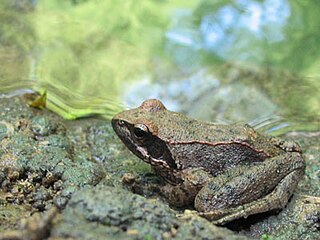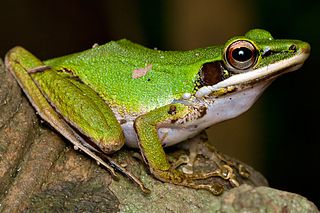
Rana is a genus of frogs commonly known as the Holarctic true frogs, pond frogs or brown frogs. Members of this genus are found through much of Eurasia and western North America. Many other genera were formerly included here. These true frogs are usually largish species characterized by their slim waists and wrinkled skin; many have thin ridges running along their backs, but they generally lack "warts" as in typical toads. They are excellent jumpers due to their long, slender legs. The typical webbing found on their hind feet allows for easy movement through water. Coloration is mostly greens and browns above, with darker and yellowish spots.

The Italian agile frog, also known as Lataste's frog, is a species of frog in the family Ranidae. The species is native to southern Europe.

Rana amurensis is a species of true frog found in northern Asia. It ranges across western Siberia, as well as northeastern China, northeastern Mongolia, and on the northern Korean Peninsula and on Sakhalin. Rana coreana was previously included in this species as a subspecies. Found at latitudes up to 71° N, it is the northernmost wild amphibian species.

The common green frog is a frog species of in the true frog family Ranidae; some sources still use the old name Rana erythraea. It lives in Southeast Asia and is also known as green paddy frog, red-eared frog or leaf frog. The last name, however, commonly refers to the Neotropical tree frogs which make up the subfamily Phyllomedusinae. These are not closely related to H. erythraea, belonging to family Hylidae instead.

The Greek stream frog or simply Greek frog is a species of frog in the family Ranidae found in Albania, Bosnia and Herzegovina, Bulgaria, Greece, North Macedonia, Serbia and Montenegro, and Turkey. Its natural habitats are temperate forests, temperate grassland, rivers, intermittent rivers, freshwater springs, and pastureland. It is not considered threatened by the IUCN.

The Italian stream frog, also called the Italian frog, is a species of frog in the family Ranidae. The species is endemic to Italy and San Marino.
The plateau brown frog or plateau wood frog is a species of frog in the family Ranidae, endemic to the plateau region of western China. It was previously included in Rana chensinensis but it now considered a valid species. It is a common frog in suitable habitats that include alpine meadows, marshland and grassland. It hibernates in streams. It is not considered threatened by the IUCN.

The long-legged wood frog, also known as Caucasus frog, or Uludağ frog, is a species of frog in the family Ranidae found in Armenia, Azerbaijan, Georgia, Iran, Russia, Turkey, and Turkmenistan. Its natural habitats are boreal forests, temperate forests, temperate shrubland, subtropical or tropical dry shrubland, temperate grassland, rivers, intermittent rivers, swamps, freshwater lakes, intermittent freshwater lakes, freshwater marshes, intermittent freshwater marshes, freshwater springs, rocky areas, arable land, pastureland, plantations, rural gardens, urban areas, water storage areas, ponds, and introduced vegetation. It is not considered threatened by the IUCN.

The Taurus frog, is an frog species of the Ranidae family endemic to Turkey, varying in size from 6.0 to 7.5cm. It is the only extant frog species that doesn't croak. Although it was only thought to be present in Karagöl and Çiniligöl, research conducted in 2007 revealed Eğrigöl as another habitat where the species is present.

The highland frog, also known as the masked mountain frog, is a species of frog in the family Ranidae, known from El Salvador, Guatemala, Honduras, Mexico, and Nicaragua. Its natural habitats are subtropical or tropical moist lowland forests, subtropical or tropical moist montane forests, rivers, and freshwater marshes. It is threatened by habitat loss.
Pseudorana sangzhiensis or Rana sangzhiensis is a species of frog in the family Ranidae, the "true frogs". It is endemic to China. It is known only from Mount Tianping, in Sangzhi County, Hunan, and depending on the source, from Mount Dadong in Lianxian County, Guangdong, or from Mount Emei in Sichuan. Common names Sangzhi frog and Sangzhi groove-toed frog has been proposed for it.

The Tago's brown frog or simply Tago frog is a species of frog in the family Ranidae endemic to Japan. It is widely distributed within Japan and found on Honshu, Shikoku, and Kyushu, as well as on some outlying islands. There are two subspecies:

Vaillant's frog is a species of frog in the family Ranidae found in Central America. Its natural habitats are subtropical or tropical dry forests, subtropical or tropical moist lowland forests, subtropical or tropical swamps, rivers, swamps, freshwater lakes, intermittent freshwater lakes, freshwater marshes, intermittent freshwater marshes, rural gardens, heavily degraded former forests, water storage areas, ponds, and canals and ditches.
The Zhenhai brown frog is a species of frog in the family Ranidae endemic to China. Its natural habitats are subtropical or tropical moist lowland forests, subtropical or tropical moist montane forests, subtropical or tropical dry lowland grasslands, intermittent freshwater marshes, ponds, and irrigated land. It is not considered threatened by the IUCN.
Chalcorana labialis, also known as the white-lipped frog, is a species of "true frog" in the family Ranidae. As currently known, it is endemic to Peninsular Malaysia, although it might also occur in Singapore. Molecular data suggest presence of three distinct lineages in the same area, one of which is not closely related to Chalcorana labialis and which could represent an unnamed species.

The Korean brown frog is a species of frog in the genus Rana. It is native to the Korean Peninsula and Shandong, China.
Chalcorana chalconota is a species of "true frog", family Ranidae. It is endemic to Indonesia and occurs in southern Sumatra, Java, Bali, and a few smaller islands. Populations previously assigned to this species now belong to a number of other Chalcorana species, leading to the current delineation of Chalcorana chalconota with a much narrower range. This species is also known as the Schlegel's frog, brown stream frog, copper-cheeked frog, or, among with many other species, white-lipped frog.

Chalcorana eschatia is a species of "true frog" in the family Ranidae. It is known from southern Thailand, but is likely to be more widespread. It was split off from Chalcorana chalconota by Robert Inger and colleagues in 2009, along with a number of other species in so-called "Rana chalconota group". The specific name eschatia, derived from the Greek word for "outskirt", refers to distribution of this species being at the edge of the geographical range of the group.

Chalcorana megalonesa is a species of true frog in the family Ranidae, the "true frogs". It is endemic to Borneo and is known from both Malaysia and Indonesia (Kalimantan). It was split off from Rana chalconota in 2009 by Robert Inger and colleagues, along with a number of other species. Common name large white-lipped frog has been coined for it.

Chalcorana raniceps, also known as the copper-cheeked frog, white-lipped frog, or Peters' Malaysian frog, is a species of "true frog" in the family Ranidae. It is endemic to Borneo, including Brunei Darussalam, Kalimantan (Indonesia), and Sarawak (Malaysia), although it is likely to occur more widely. Previously mixed with Chalcorana chalconota and believed to have much wider distribution, its range was delimited to Borneo in the revision of "Rana chalconota" complex by Robert Inger and colleagues in 2009.















